Management and Operations: Leadership, Roles and Theories Report
VerifiedAdded on 2021/04/16
|19
|4413
|51
Report
AI Summary
This report provides a comprehensive overview of management and operations within an organization. It begins by defining and comparing the roles and characteristics of leaders and managers, highlighting their distinct responsibilities and contributions. The report then explores the application of leadership and management functions in various situational contexts, providing real-world examples. It delves into key theories such as situational leadership, system leadership, and contingency leadership, explaining their principles and implications. Furthermore, the report examines key approaches to operations management, emphasizing the roles of leaders and managers in this domain and their impact on achieving business objectives. Finally, it discusses the various factors within the organizational environment that influence management practices, offering a holistic perspective on the subject.
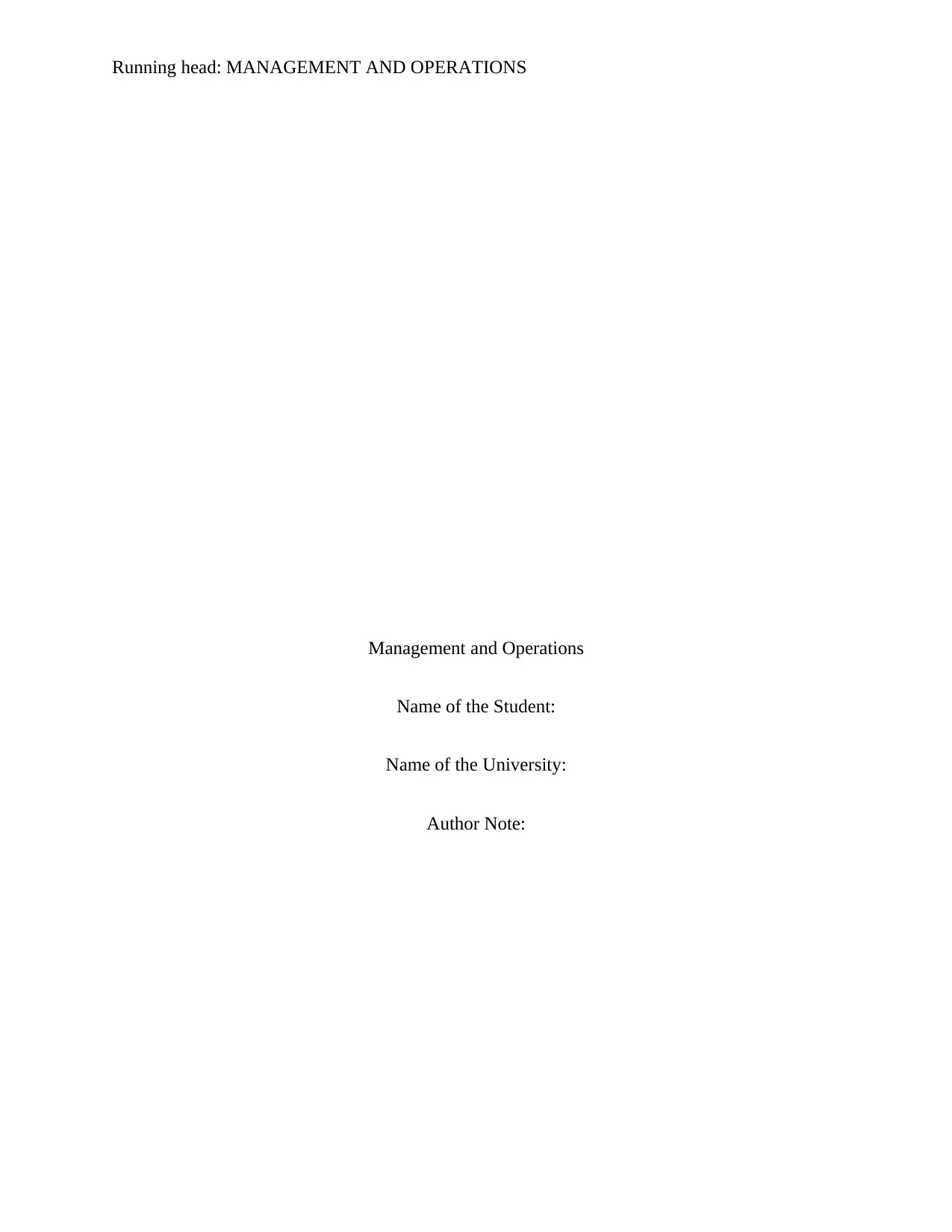
Running head: MANAGEMENT AND OPERATIONS
Management and Operations
Name of the Student:
Name of the University:
Author Note:
Management and Operations
Name of the Student:
Name of the University:
Author Note:
Paraphrase This Document
Need a fresh take? Get an instant paraphrase of this document with our AI Paraphraser
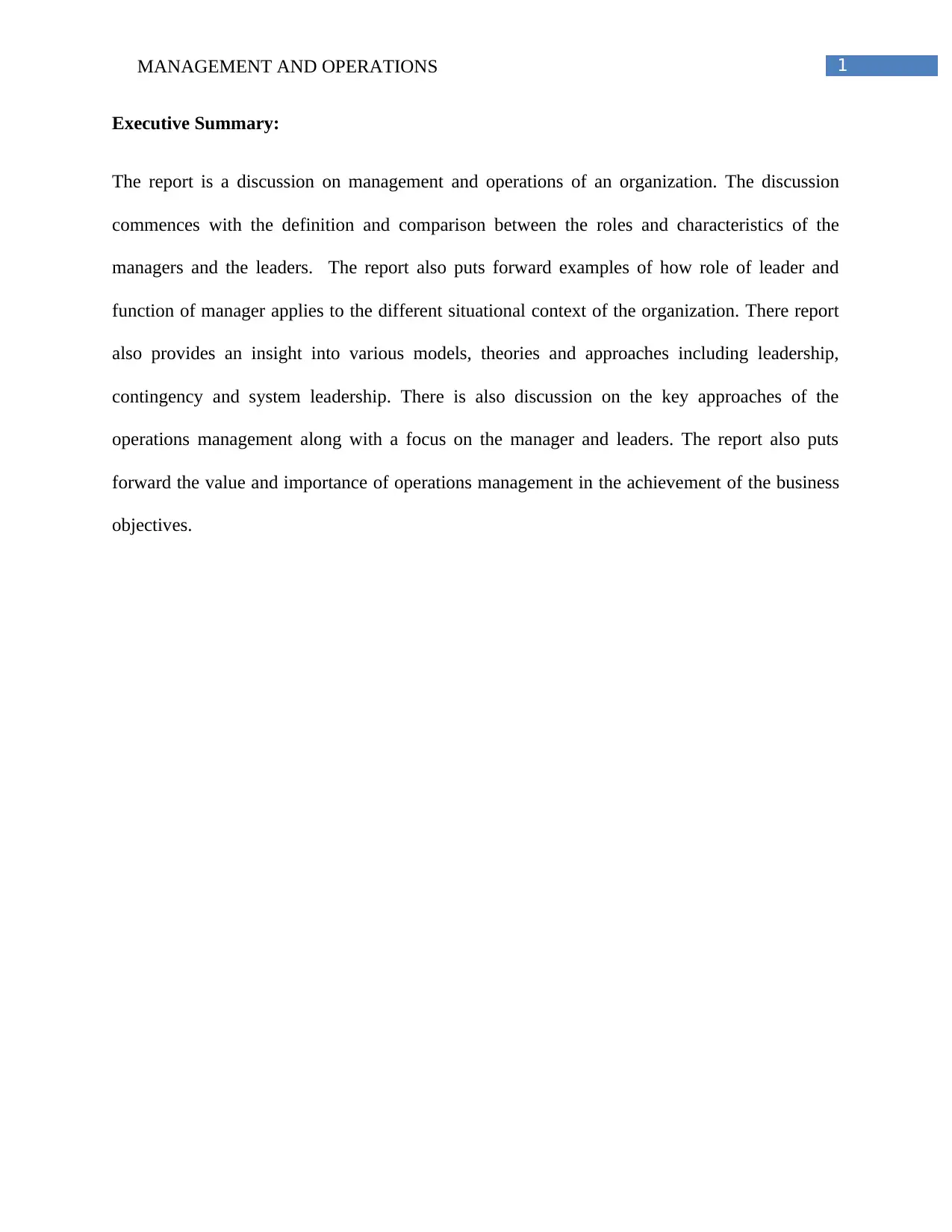
1MANAGEMENT AND OPERATIONS
Executive Summary:
The report is a discussion on management and operations of an organization. The discussion
commences with the definition and comparison between the roles and characteristics of the
managers and the leaders. The report also puts forward examples of how role of leader and
function of manager applies to the different situational context of the organization. There report
also provides an insight into various models, theories and approaches including leadership,
contingency and system leadership. There is also discussion on the key approaches of the
operations management along with a focus on the manager and leaders. The report also puts
forward the value and importance of operations management in the achievement of the business
objectives.
Executive Summary:
The report is a discussion on management and operations of an organization. The discussion
commences with the definition and comparison between the roles and characteristics of the
managers and the leaders. The report also puts forward examples of how role of leader and
function of manager applies to the different situational context of the organization. There report
also provides an insight into various models, theories and approaches including leadership,
contingency and system leadership. There is also discussion on the key approaches of the
operations management along with a focus on the manager and leaders. The report also puts
forward the value and importance of operations management in the achievement of the business
objectives.
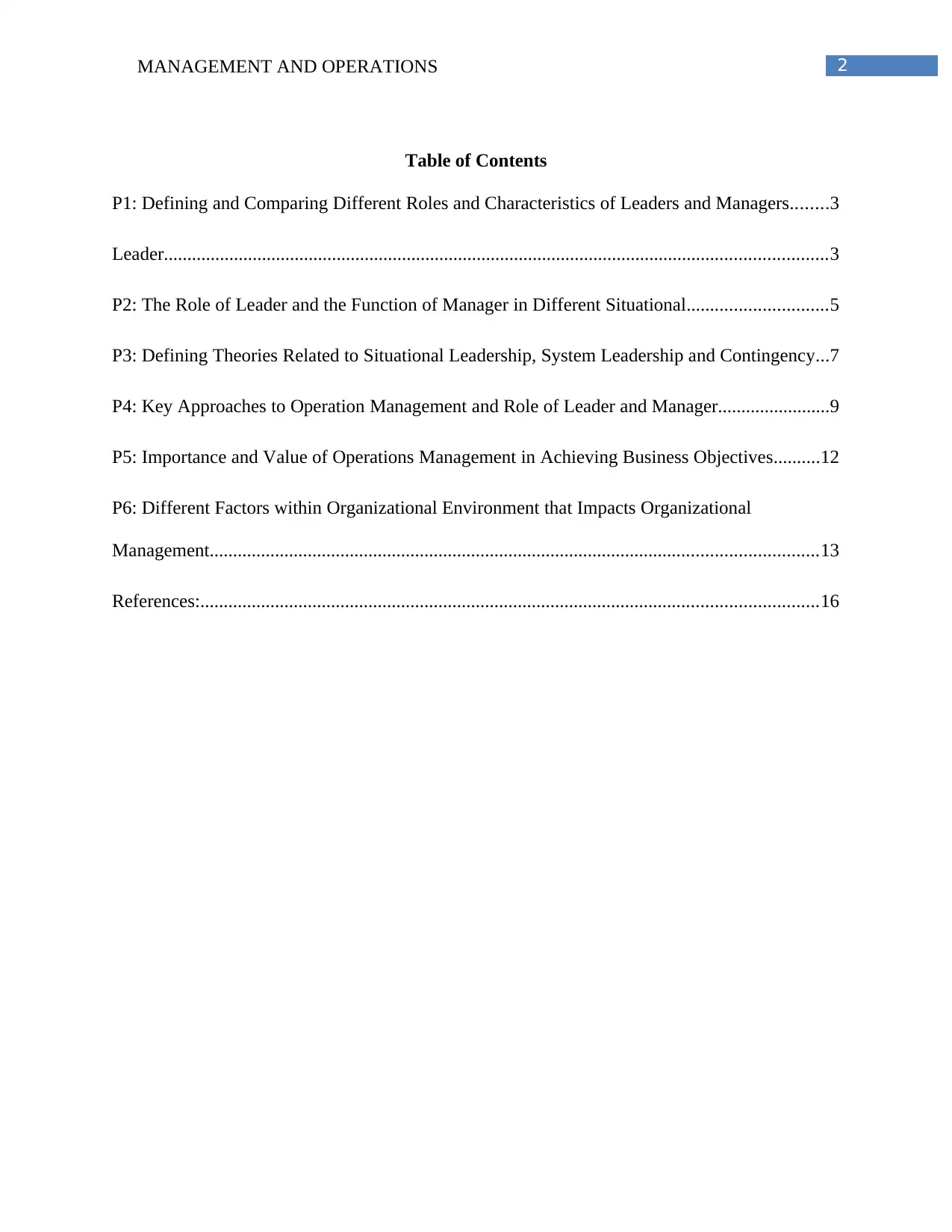
2MANAGEMENT AND OPERATIONS
Table of Contents
P1: Defining and Comparing Different Roles and Characteristics of Leaders and Managers........3
Leader..............................................................................................................................................3
P2: The Role of Leader and the Function of Manager in Different Situational..............................5
P3: Defining Theories Related to Situational Leadership, System Leadership and Contingency...7
P4: Key Approaches to Operation Management and Role of Leader and Manager........................9
P5: Importance and Value of Operations Management in Achieving Business Objectives..........12
P6: Different Factors within Organizational Environment that Impacts Organizational
Management..................................................................................................................................13
References:....................................................................................................................................16
Table of Contents
P1: Defining and Comparing Different Roles and Characteristics of Leaders and Managers........3
Leader..............................................................................................................................................3
P2: The Role of Leader and the Function of Manager in Different Situational..............................5
P3: Defining Theories Related to Situational Leadership, System Leadership and Contingency...7
P4: Key Approaches to Operation Management and Role of Leader and Manager........................9
P5: Importance and Value of Operations Management in Achieving Business Objectives..........12
P6: Different Factors within Organizational Environment that Impacts Organizational
Management..................................................................................................................................13
References:....................................................................................................................................16
⊘ This is a preview!⊘
Do you want full access?
Subscribe today to unlock all pages.

Trusted by 1+ million students worldwide
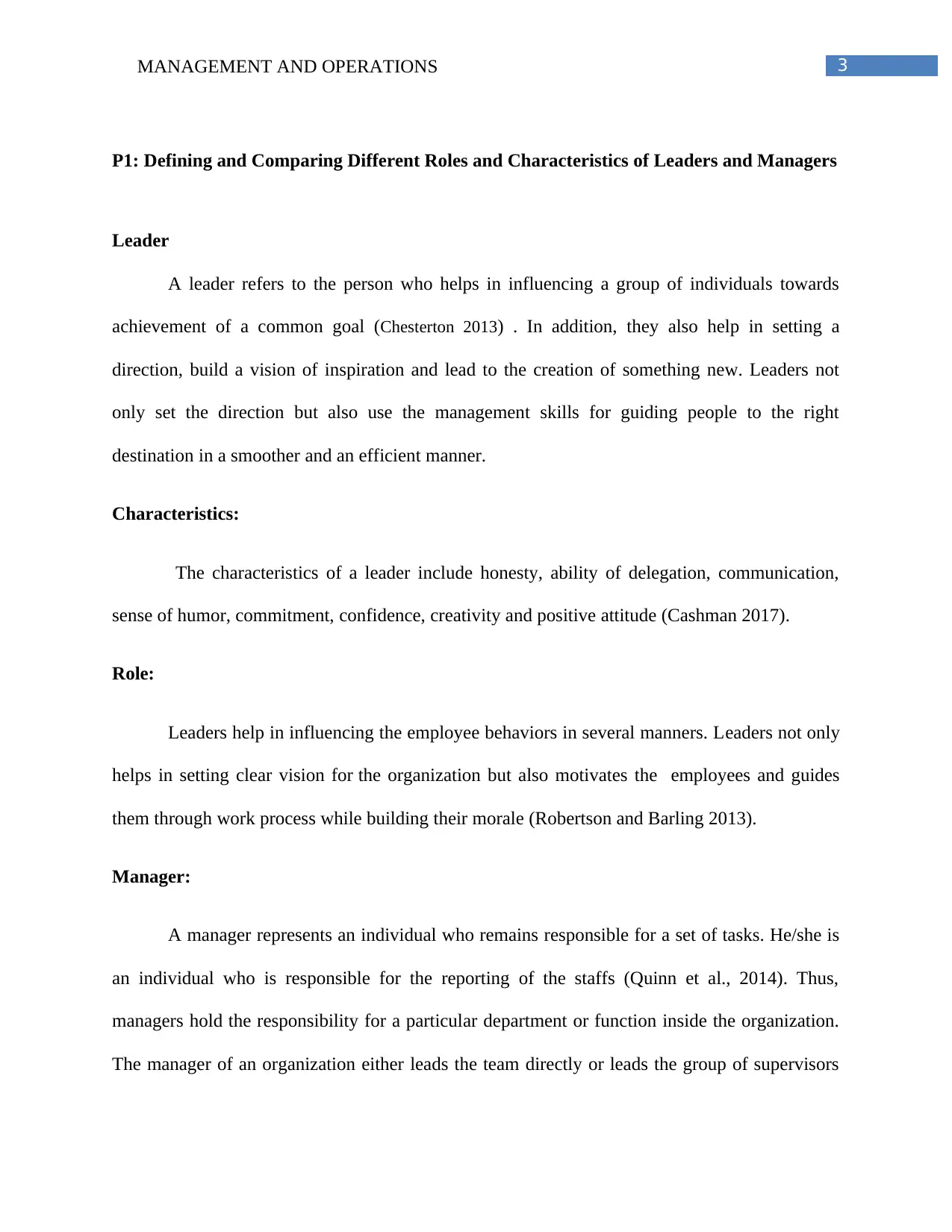
3MANAGEMENT AND OPERATIONS
P1: Defining and Comparing Different Roles and Characteristics of Leaders and Managers
Leader
A leader refers to the person who helps in influencing a group of individuals towards
achievement of a common goal (Chesterton 2013) . In addition, they also help in setting a
direction, build a vision of inspiration and lead to the creation of something new. Leaders not
only set the direction but also use the management skills for guiding people to the right
destination in a smoother and an efficient manner.
Characteristics:
The characteristics of a leader include honesty, ability of delegation, communication,
sense of humor, commitment, confidence, creativity and positive attitude (Cashman 2017).
Role:
Leaders help in influencing the employee behaviors in several manners. Leaders not only
helps in setting clear vision for the organization but also motivates the employees and guides
them through work process while building their morale (Robertson and Barling 2013).
Manager:
A manager represents an individual who remains responsible for a set of tasks. He/she is
an individual who is responsible for the reporting of the staffs (Quinn et al., 2014). Thus,
managers hold the responsibility for a particular department or function inside the organization.
The manager of an organization either leads the team directly or leads the group of supervisors
P1: Defining and Comparing Different Roles and Characteristics of Leaders and Managers
Leader
A leader refers to the person who helps in influencing a group of individuals towards
achievement of a common goal (Chesterton 2013) . In addition, they also help in setting a
direction, build a vision of inspiration and lead to the creation of something new. Leaders not
only set the direction but also use the management skills for guiding people to the right
destination in a smoother and an efficient manner.
Characteristics:
The characteristics of a leader include honesty, ability of delegation, communication,
sense of humor, commitment, confidence, creativity and positive attitude (Cashman 2017).
Role:
Leaders help in influencing the employee behaviors in several manners. Leaders not only
helps in setting clear vision for the organization but also motivates the employees and guides
them through work process while building their morale (Robertson and Barling 2013).
Manager:
A manager represents an individual who remains responsible for a set of tasks. He/she is
an individual who is responsible for the reporting of the staffs (Quinn et al., 2014). Thus,
managers hold the responsibility for a particular department or function inside the organization.
The manager of an organization either leads the team directly or leads the group of supervisors
Paraphrase This Document
Need a fresh take? Get an instant paraphrase of this document with our AI Paraphraser
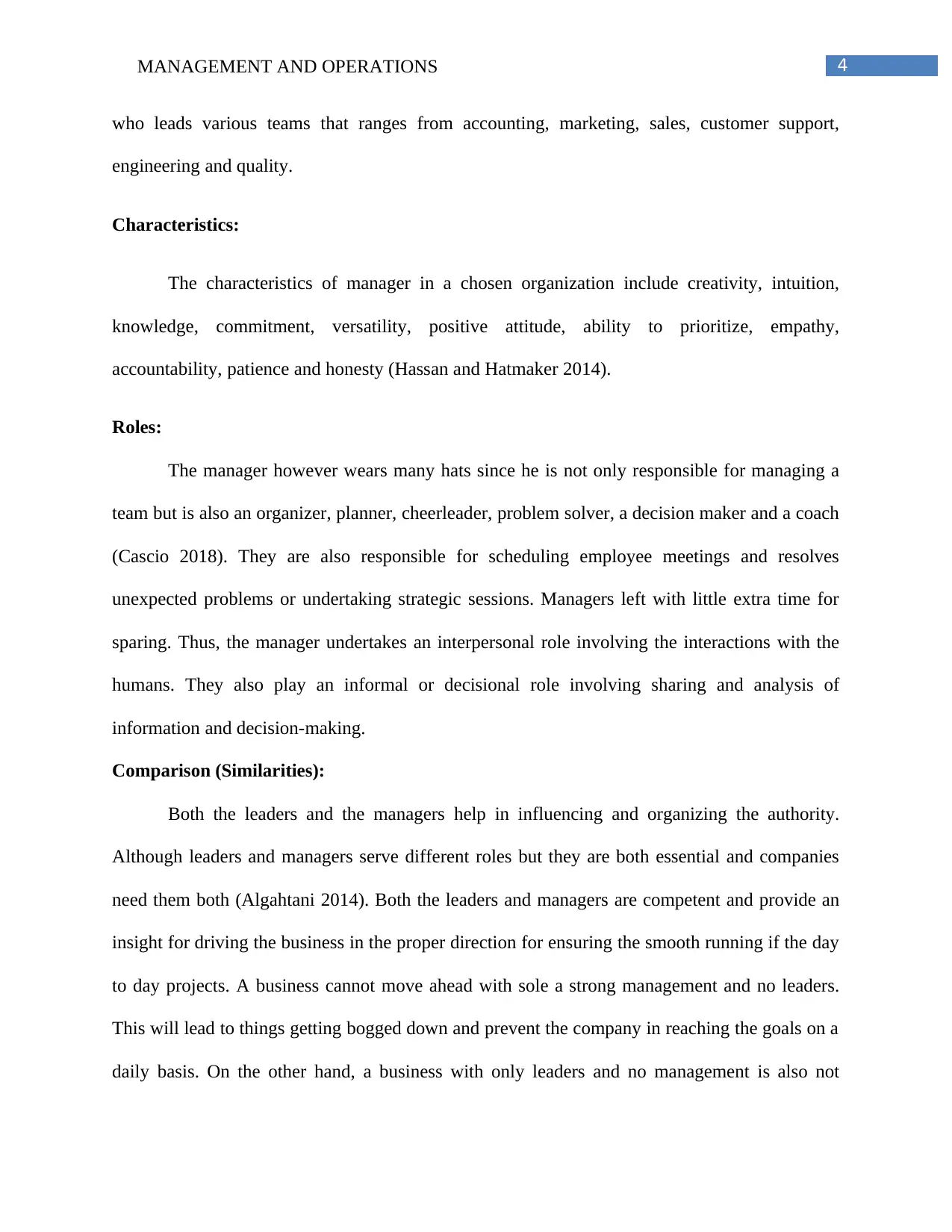
4MANAGEMENT AND OPERATIONS
who leads various teams that ranges from accounting, marketing, sales, customer support,
engineering and quality.
Characteristics:
The characteristics of manager in a chosen organization include creativity, intuition,
knowledge, commitment, versatility, positive attitude, ability to prioritize, empathy,
accountability, patience and honesty (Hassan and Hatmaker 2014).
Roles:
The manager however wears many hats since he is not only responsible for managing a
team but is also an organizer, planner, cheerleader, problem solver, a decision maker and a coach
(Cascio 2018). They are also responsible for scheduling employee meetings and resolves
unexpected problems or undertaking strategic sessions. Managers left with little extra time for
sparing. Thus, the manager undertakes an interpersonal role involving the interactions with the
humans. They also play an informal or decisional role involving sharing and analysis of
information and decision-making.
Comparison (Similarities):
Both the leaders and the managers help in influencing and organizing the authority.
Although leaders and managers serve different roles but they are both essential and companies
need them both (Algahtani 2014). Both the leaders and managers are competent and provide an
insight for driving the business in the proper direction for ensuring the smooth running if the day
to day projects. A business cannot move ahead with sole a strong management and no leaders.
This will lead to things getting bogged down and prevent the company in reaching the goals on a
daily basis. On the other hand, a business with only leaders and no management is also not
who leads various teams that ranges from accounting, marketing, sales, customer support,
engineering and quality.
Characteristics:
The characteristics of manager in a chosen organization include creativity, intuition,
knowledge, commitment, versatility, positive attitude, ability to prioritize, empathy,
accountability, patience and honesty (Hassan and Hatmaker 2014).
Roles:
The manager however wears many hats since he is not only responsible for managing a
team but is also an organizer, planner, cheerleader, problem solver, a decision maker and a coach
(Cascio 2018). They are also responsible for scheduling employee meetings and resolves
unexpected problems or undertaking strategic sessions. Managers left with little extra time for
sparing. Thus, the manager undertakes an interpersonal role involving the interactions with the
humans. They also play an informal or decisional role involving sharing and analysis of
information and decision-making.
Comparison (Similarities):
Both the leaders and the managers help in influencing and organizing the authority.
Although leaders and managers serve different roles but they are both essential and companies
need them both (Algahtani 2014). Both the leaders and managers are competent and provide an
insight for driving the business in the proper direction for ensuring the smooth running if the day
to day projects. A business cannot move ahead with sole a strong management and no leaders.
This will lead to things getting bogged down and prevent the company in reaching the goals on a
daily basis. On the other hand, a business with only leaders and no management is also not

5MANAGEMENT AND OPERATIONS
feasible. In this case, there would be envisioning of the steps but they could not be forwarded in
the absence of a manager. Thus, in other words, management is doing things right for an n
organization whereas the leadership implies on doing right things to keep the company moving.
P2: The Role of Leader and the Function of Manager in Different Situational
Contexts in the Organization
Role:
A leader represents some who is responsible for providing directions, guidance and
instructions to the group of individuals, usually known as the team, for achieving a common
goal(Ma Prieto and Pilar Perez-Santana 2014). They also undertake communication with the
team members and thereby monitor them.
Examples of Roles of Leaders in Different Situation Context:
The roles played by a leader are either formal or informal. In the formal roles, the leader
designates responsibilities within the position thereby encouraging the employees in following
them (Miner 2015). However, informal roles are situations where the leaders make use of
personal traits like charisma, empathy, compassion and inspiration for motivating others.
Role of the Supervisor: This is the common role of leader in an organization. This
involves monitoring of the deadlines and the work performance, delegation of the task and
entailing proper communication before, during and after the completion of the work. Thus,
effective supervision acts as a key to the high functioning company.
Role of a Coach: Leaders undertakes this role for mentoring and coaching the employees.
This involves selection of the right kind of people for the work, getting the employees acclimated
feasible. In this case, there would be envisioning of the steps but they could not be forwarded in
the absence of a manager. Thus, in other words, management is doing things right for an n
organization whereas the leadership implies on doing right things to keep the company moving.
P2: The Role of Leader and the Function of Manager in Different Situational
Contexts in the Organization
Role:
A leader represents some who is responsible for providing directions, guidance and
instructions to the group of individuals, usually known as the team, for achieving a common
goal(Ma Prieto and Pilar Perez-Santana 2014). They also undertake communication with the
team members and thereby monitor them.
Examples of Roles of Leaders in Different Situation Context:
The roles played by a leader are either formal or informal. In the formal roles, the leader
designates responsibilities within the position thereby encouraging the employees in following
them (Miner 2015). However, informal roles are situations where the leaders make use of
personal traits like charisma, empathy, compassion and inspiration for motivating others.
Role of the Supervisor: This is the common role of leader in an organization. This
involves monitoring of the deadlines and the work performance, delegation of the task and
entailing proper communication before, during and after the completion of the work. Thus,
effective supervision acts as a key to the high functioning company.
Role of a Coach: Leaders undertakes this role for mentoring and coaching the employees.
This involves selection of the right kind of people for the work, getting the employees acclimated
⊘ This is a preview!⊘
Do you want full access?
Subscribe today to unlock all pages.

Trusted by 1+ million students worldwide
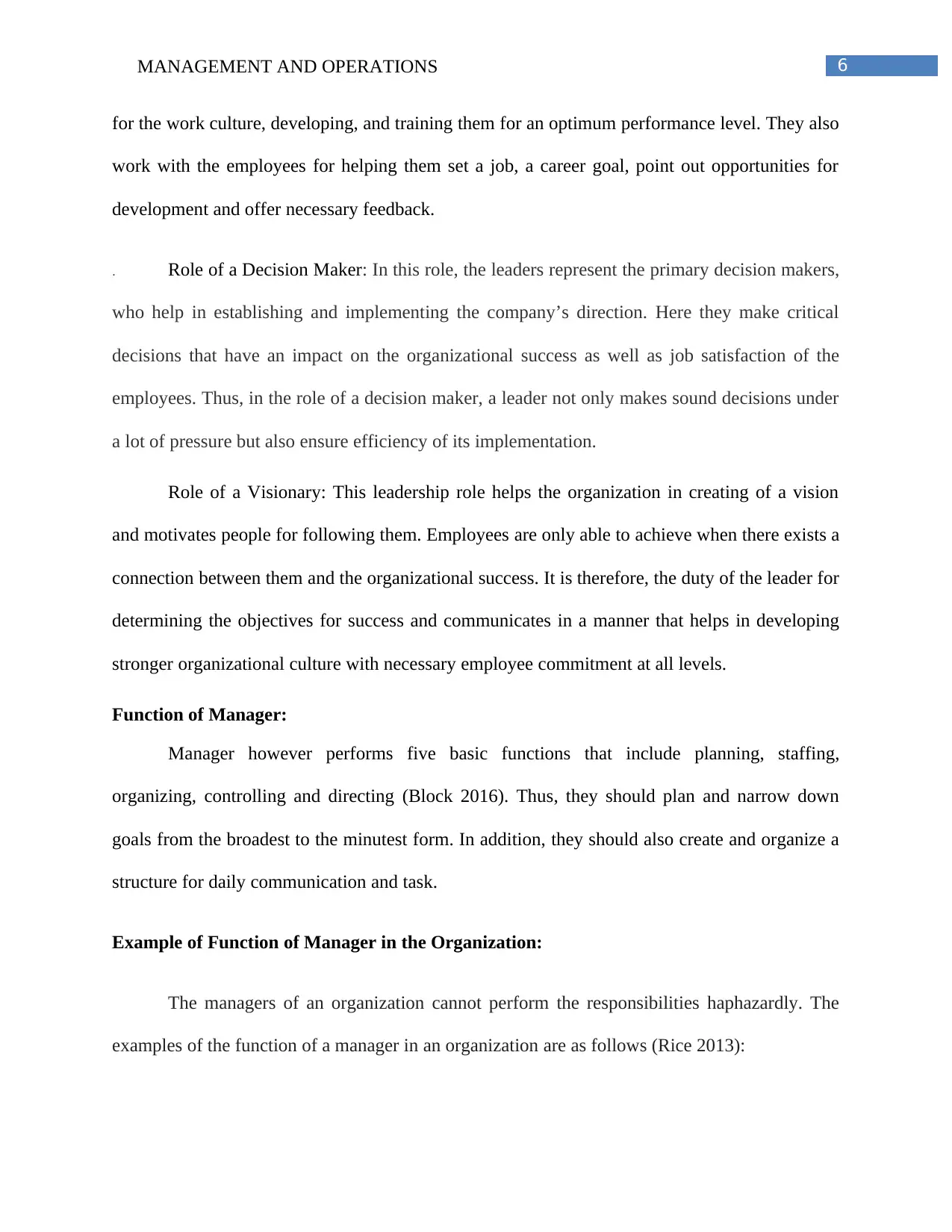
6MANAGEMENT AND OPERATIONS
for the work culture, developing, and training them for an optimum performance level. They also
work with the employees for helping them set a job, a career goal, point out opportunities for
development and offer necessary feedback.
. Role of a Decision Maker: In this role, the leaders represent the primary decision makers,
who help in establishing and implementing the company’s direction. Here they make critical
decisions that have an impact on the organizational success as well as job satisfaction of the
employees. Thus, in the role of a decision maker, a leader not only makes sound decisions under
a lot of pressure but also ensure efficiency of its implementation.
Role of a Visionary: This leadership role helps the organization in creating of a vision
and motivates people for following them. Employees are only able to achieve when there exists a
connection between them and the organizational success. It is therefore, the duty of the leader for
determining the objectives for success and communicates in a manner that helps in developing
stronger organizational culture with necessary employee commitment at all levels.
Function of Manager:
Manager however performs five basic functions that include planning, staffing,
organizing, controlling and directing (Block 2016). Thus, they should plan and narrow down
goals from the broadest to the minutest form. In addition, they should also create and organize a
structure for daily communication and task.
Example of Function of Manager in the Organization:
The managers of an organization cannot perform the responsibilities haphazardly. The
examples of the function of a manager in an organization are as follows (Rice 2013):
for the work culture, developing, and training them for an optimum performance level. They also
work with the employees for helping them set a job, a career goal, point out opportunities for
development and offer necessary feedback.
. Role of a Decision Maker: In this role, the leaders represent the primary decision makers,
who help in establishing and implementing the company’s direction. Here they make critical
decisions that have an impact on the organizational success as well as job satisfaction of the
employees. Thus, in the role of a decision maker, a leader not only makes sound decisions under
a lot of pressure but also ensure efficiency of its implementation.
Role of a Visionary: This leadership role helps the organization in creating of a vision
and motivates people for following them. Employees are only able to achieve when there exists a
connection between them and the organizational success. It is therefore, the duty of the leader for
determining the objectives for success and communicates in a manner that helps in developing
stronger organizational culture with necessary employee commitment at all levels.
Function of Manager:
Manager however performs five basic functions that include planning, staffing,
organizing, controlling and directing (Block 2016). Thus, they should plan and narrow down
goals from the broadest to the minutest form. In addition, they should also create and organize a
structure for daily communication and task.
Example of Function of Manager in the Organization:
The managers of an organization cannot perform the responsibilities haphazardly. The
examples of the function of a manager in an organization are as follows (Rice 2013):
Paraphrase This Document
Need a fresh take? Get an instant paraphrase of this document with our AI Paraphraser
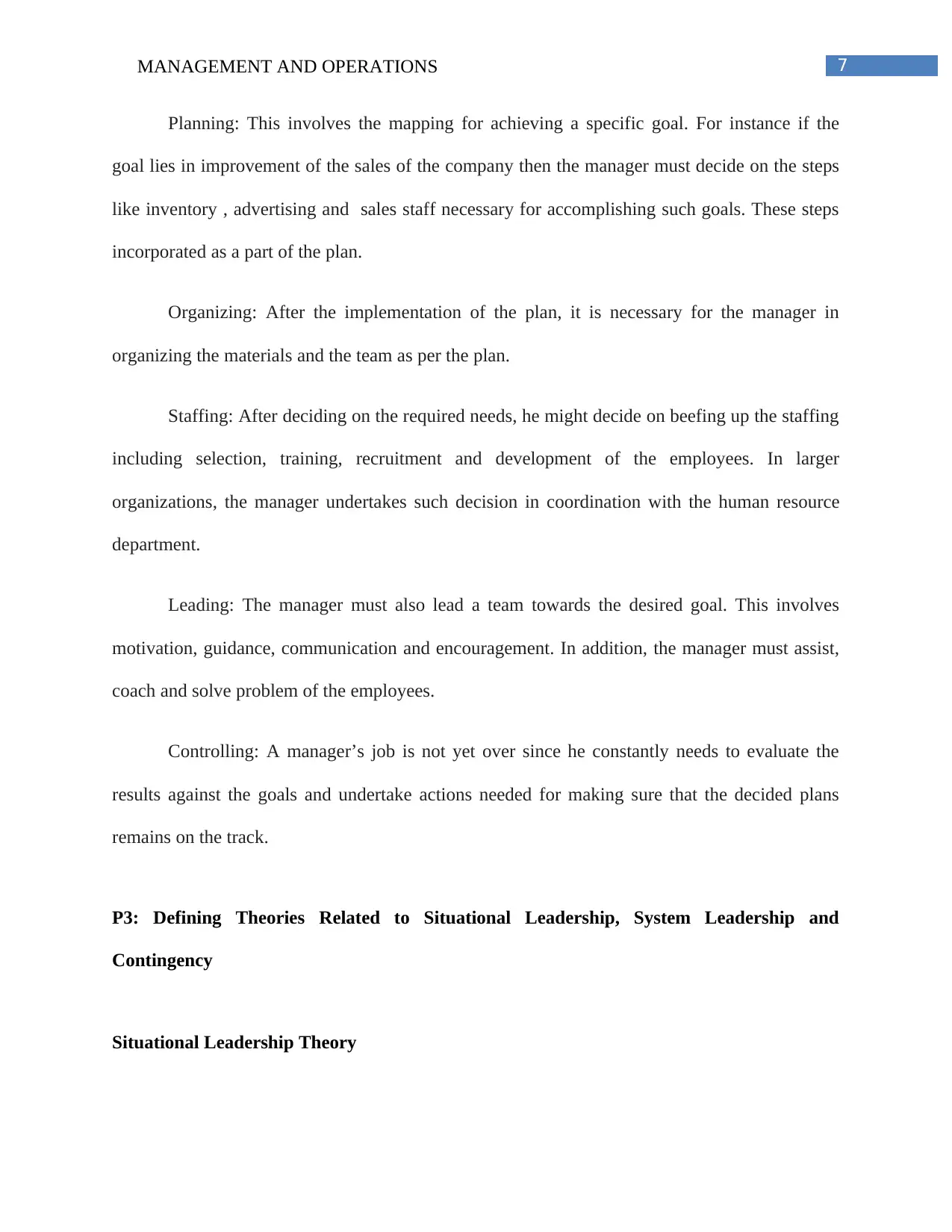
7MANAGEMENT AND OPERATIONS
Planning: This involves the mapping for achieving a specific goal. For instance if the
goal lies in improvement of the sales of the company then the manager must decide on the steps
like inventory , advertising and sales staff necessary for accomplishing such goals. These steps
incorporated as a part of the plan.
Organizing: After the implementation of the plan, it is necessary for the manager in
organizing the materials and the team as per the plan.
Staffing: After deciding on the required needs, he might decide on beefing up the staffing
including selection, training, recruitment and development of the employees. In larger
organizations, the manager undertakes such decision in coordination with the human resource
department.
Leading: The manager must also lead a team towards the desired goal. This involves
motivation, guidance, communication and encouragement. In addition, the manager must assist,
coach and solve problem of the employees.
Controlling: A manager’s job is not yet over since he constantly needs to evaluate the
results against the goals and undertake actions needed for making sure that the decided plans
remains on the track.
P3: Defining Theories Related to Situational Leadership, System Leadership and
Contingency
Situational Leadership Theory
Planning: This involves the mapping for achieving a specific goal. For instance if the
goal lies in improvement of the sales of the company then the manager must decide on the steps
like inventory , advertising and sales staff necessary for accomplishing such goals. These steps
incorporated as a part of the plan.
Organizing: After the implementation of the plan, it is necessary for the manager in
organizing the materials and the team as per the plan.
Staffing: After deciding on the required needs, he might decide on beefing up the staffing
including selection, training, recruitment and development of the employees. In larger
organizations, the manager undertakes such decision in coordination with the human resource
department.
Leading: The manager must also lead a team towards the desired goal. This involves
motivation, guidance, communication and encouragement. In addition, the manager must assist,
coach and solve problem of the employees.
Controlling: A manager’s job is not yet over since he constantly needs to evaluate the
results against the goals and undertake actions needed for making sure that the decided plans
remains on the track.
P3: Defining Theories Related to Situational Leadership, System Leadership and
Contingency
Situational Leadership Theory
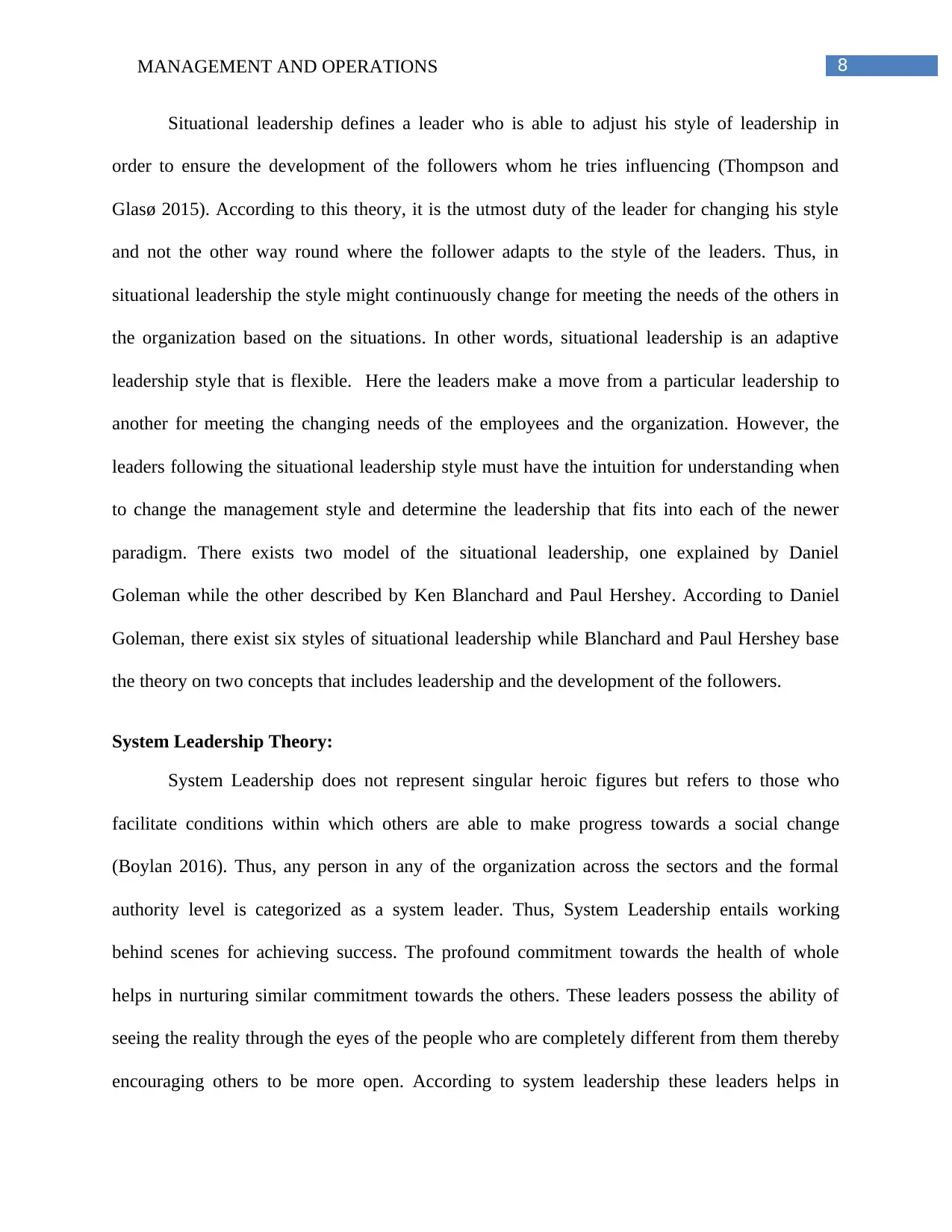
8MANAGEMENT AND OPERATIONS
Situational leadership defines a leader who is able to adjust his style of leadership in
order to ensure the development of the followers whom he tries influencing (Thompson and
Glasø 2015). According to this theory, it is the utmost duty of the leader for changing his style
and not the other way round where the follower adapts to the style of the leaders. Thus, in
situational leadership the style might continuously change for meeting the needs of the others in
the organization based on the situations. In other words, situational leadership is an adaptive
leadership style that is flexible. Here the leaders make a move from a particular leadership to
another for meeting the changing needs of the employees and the organization. However, the
leaders following the situational leadership style must have the intuition for understanding when
to change the management style and determine the leadership that fits into each of the newer
paradigm. There exists two model of the situational leadership, one explained by Daniel
Goleman while the other described by Ken Blanchard and Paul Hershey. According to Daniel
Goleman, there exist six styles of situational leadership while Blanchard and Paul Hershey base
the theory on two concepts that includes leadership and the development of the followers.
System Leadership Theory:
System Leadership does not represent singular heroic figures but refers to those who
facilitate conditions within which others are able to make progress towards a social change
(Boylan 2016). Thus, any person in any of the organization across the sectors and the formal
authority level is categorized as a system leader. Thus, System Leadership entails working
behind scenes for achieving success. The profound commitment towards the health of whole
helps in nurturing similar commitment towards the others. These leaders possess the ability of
seeing the reality through the eyes of the people who are completely different from them thereby
encouraging others to be more open. According to system leadership these leaders helps in
Situational leadership defines a leader who is able to adjust his style of leadership in
order to ensure the development of the followers whom he tries influencing (Thompson and
Glasø 2015). According to this theory, it is the utmost duty of the leader for changing his style
and not the other way round where the follower adapts to the style of the leaders. Thus, in
situational leadership the style might continuously change for meeting the needs of the others in
the organization based on the situations. In other words, situational leadership is an adaptive
leadership style that is flexible. Here the leaders make a move from a particular leadership to
another for meeting the changing needs of the employees and the organization. However, the
leaders following the situational leadership style must have the intuition for understanding when
to change the management style and determine the leadership that fits into each of the newer
paradigm. There exists two model of the situational leadership, one explained by Daniel
Goleman while the other described by Ken Blanchard and Paul Hershey. According to Daniel
Goleman, there exist six styles of situational leadership while Blanchard and Paul Hershey base
the theory on two concepts that includes leadership and the development of the followers.
System Leadership Theory:
System Leadership does not represent singular heroic figures but refers to those who
facilitate conditions within which others are able to make progress towards a social change
(Boylan 2016). Thus, any person in any of the organization across the sectors and the formal
authority level is categorized as a system leader. Thus, System Leadership entails working
behind scenes for achieving success. The profound commitment towards the health of whole
helps in nurturing similar commitment towards the others. These leaders possess the ability of
seeing the reality through the eyes of the people who are completely different from them thereby
encouraging others to be more open. According to system leadership these leaders helps in
⊘ This is a preview!⊘
Do you want full access?
Subscribe today to unlock all pages.

Trusted by 1+ million students worldwide
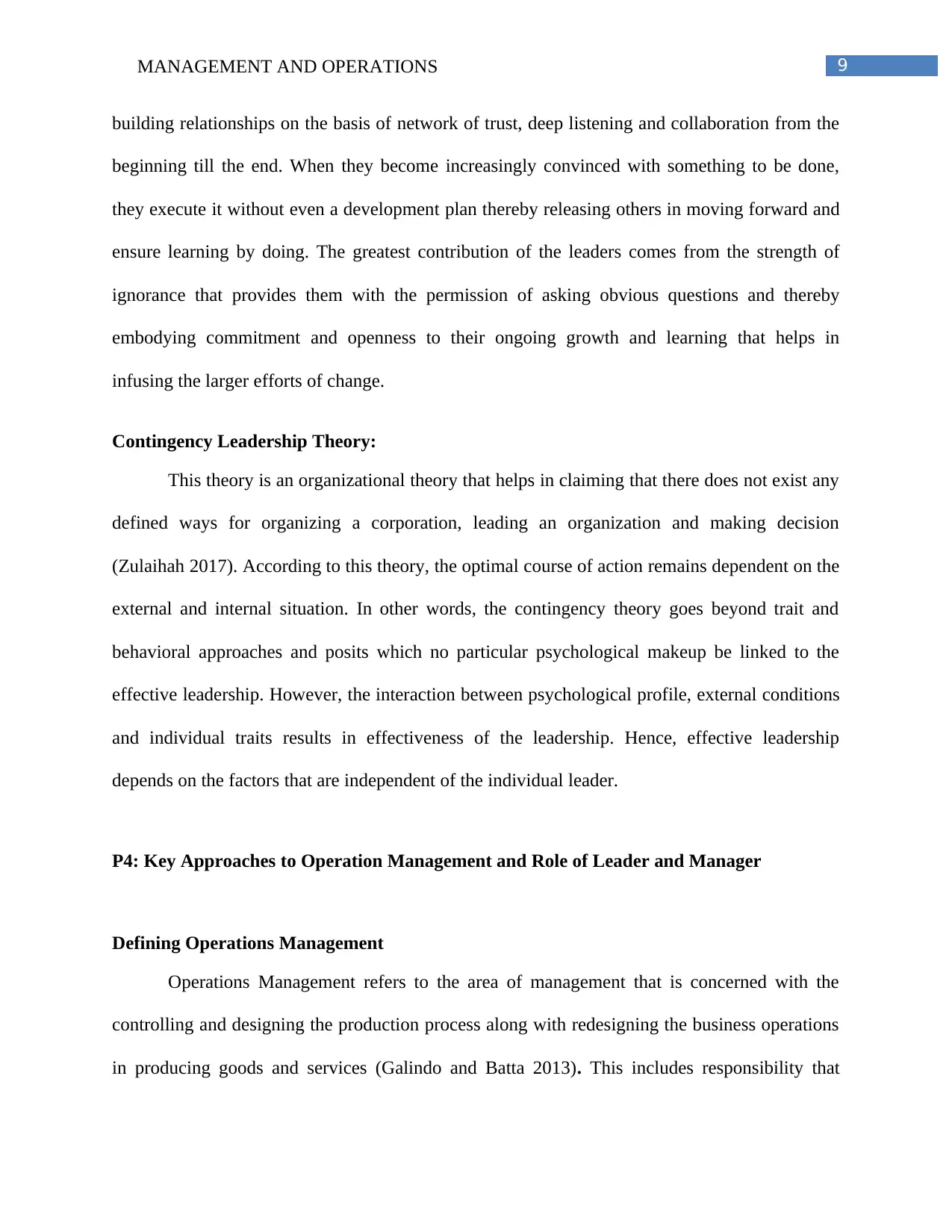
9MANAGEMENT AND OPERATIONS
building relationships on the basis of network of trust, deep listening and collaboration from the
beginning till the end. When they become increasingly convinced with something to be done,
they execute it without even a development plan thereby releasing others in moving forward and
ensure learning by doing. The greatest contribution of the leaders comes from the strength of
ignorance that provides them with the permission of asking obvious questions and thereby
embodying commitment and openness to their ongoing growth and learning that helps in
infusing the larger efforts of change.
Contingency Leadership Theory:
This theory is an organizational theory that helps in claiming that there does not exist any
defined ways for organizing a corporation, leading an organization and making decision
(Zulaihah 2017). According to this theory, the optimal course of action remains dependent on the
external and internal situation. In other words, the contingency theory goes beyond trait and
behavioral approaches and posits which no particular psychological makeup be linked to the
effective leadership. However, the interaction between psychological profile, external conditions
and individual traits results in effectiveness of the leadership. Hence, effective leadership
depends on the factors that are independent of the individual leader.
P4: Key Approaches to Operation Management and Role of Leader and Manager
Defining Operations Management
Operations Management refers to the area of management that is concerned with the
controlling and designing the production process along with redesigning the business operations
in producing goods and services (Galindo and Batta 2013). This includes responsibility that
building relationships on the basis of network of trust, deep listening and collaboration from the
beginning till the end. When they become increasingly convinced with something to be done,
they execute it without even a development plan thereby releasing others in moving forward and
ensure learning by doing. The greatest contribution of the leaders comes from the strength of
ignorance that provides them with the permission of asking obvious questions and thereby
embodying commitment and openness to their ongoing growth and learning that helps in
infusing the larger efforts of change.
Contingency Leadership Theory:
This theory is an organizational theory that helps in claiming that there does not exist any
defined ways for organizing a corporation, leading an organization and making decision
(Zulaihah 2017). According to this theory, the optimal course of action remains dependent on the
external and internal situation. In other words, the contingency theory goes beyond trait and
behavioral approaches and posits which no particular psychological makeup be linked to the
effective leadership. However, the interaction between psychological profile, external conditions
and individual traits results in effectiveness of the leadership. Hence, effective leadership
depends on the factors that are independent of the individual leader.
P4: Key Approaches to Operation Management and Role of Leader and Manager
Defining Operations Management
Operations Management refers to the area of management that is concerned with the
controlling and designing the production process along with redesigning the business operations
in producing goods and services (Galindo and Batta 2013). This includes responsibility that
Paraphrase This Document
Need a fresh take? Get an instant paraphrase of this document with our AI Paraphraser
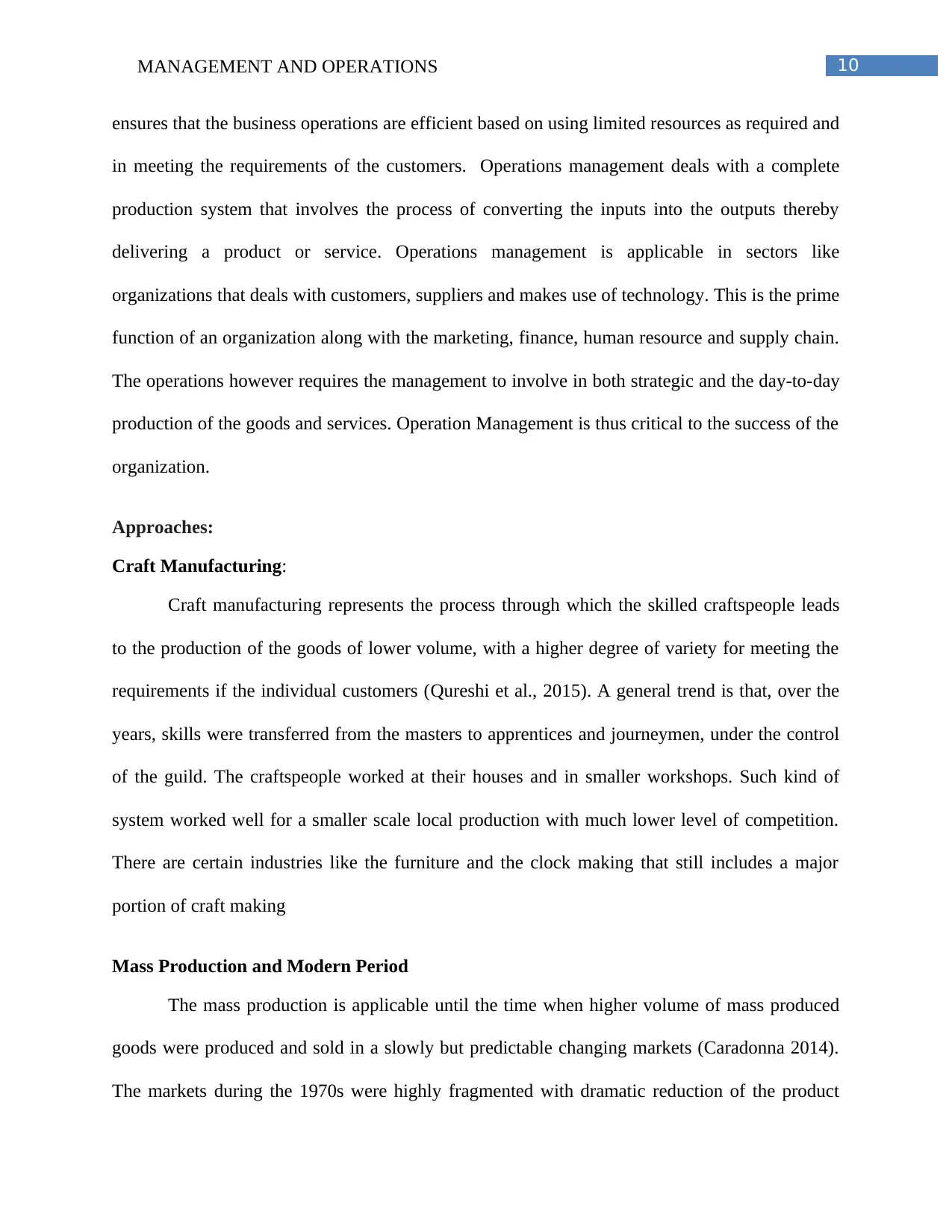
10MANAGEMENT AND OPERATIONS
ensures that the business operations are efficient based on using limited resources as required and
in meeting the requirements of the customers. Operations management deals with a complete
production system that involves the process of converting the inputs into the outputs thereby
delivering a product or service. Operations management is applicable in sectors like
organizations that deals with customers, suppliers and makes use of technology. This is the prime
function of an organization along with the marketing, finance, human resource and supply chain.
The operations however requires the management to involve in both strategic and the day-to-day
production of the goods and services. Operation Management is thus critical to the success of the
organization.
Approaches:
Craft Manufacturing:
Craft manufacturing represents the process through which the skilled craftspeople leads
to the production of the goods of lower volume, with a higher degree of variety for meeting the
requirements if the individual customers (Qureshi et al., 2015). A general trend is that, over the
years, skills were transferred from the masters to apprentices and journeymen, under the control
of the guild. The craftspeople worked at their houses and in smaller workshops. Such kind of
system worked well for a smaller scale local production with much lower level of competition.
There are certain industries like the furniture and the clock making that still includes a major
portion of craft making
Mass Production and Modern Period
The mass production is applicable until the time when higher volume of mass produced
goods were produced and sold in a slowly but predictable changing markets (Caradonna 2014).
The markets during the 1970s were highly fragmented with dramatic reduction of the product
ensures that the business operations are efficient based on using limited resources as required and
in meeting the requirements of the customers. Operations management deals with a complete
production system that involves the process of converting the inputs into the outputs thereby
delivering a product or service. Operations management is applicable in sectors like
organizations that deals with customers, suppliers and makes use of technology. This is the prime
function of an organization along with the marketing, finance, human resource and supply chain.
The operations however requires the management to involve in both strategic and the day-to-day
production of the goods and services. Operation Management is thus critical to the success of the
organization.
Approaches:
Craft Manufacturing:
Craft manufacturing represents the process through which the skilled craftspeople leads
to the production of the goods of lower volume, with a higher degree of variety for meeting the
requirements if the individual customers (Qureshi et al., 2015). A general trend is that, over the
years, skills were transferred from the masters to apprentices and journeymen, under the control
of the guild. The craftspeople worked at their houses and in smaller workshops. Such kind of
system worked well for a smaller scale local production with much lower level of competition.
There are certain industries like the furniture and the clock making that still includes a major
portion of craft making
Mass Production and Modern Period
The mass production is applicable until the time when higher volume of mass produced
goods were produced and sold in a slowly but predictable changing markets (Caradonna 2014).
The markets during the 1970s were highly fragmented with dramatic reduction of the product
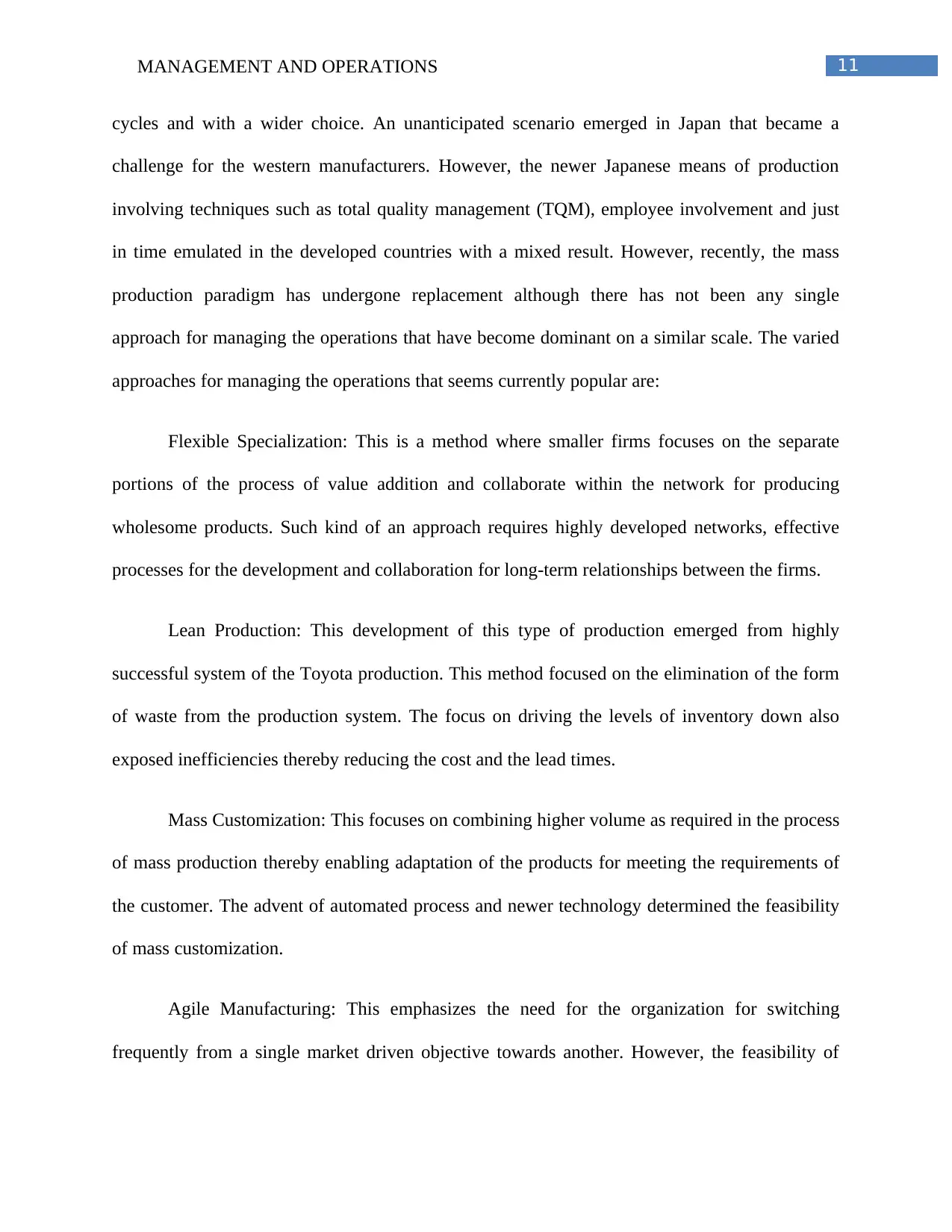
11MANAGEMENT AND OPERATIONS
cycles and with a wider choice. An unanticipated scenario emerged in Japan that became a
challenge for the western manufacturers. However, the newer Japanese means of production
involving techniques such as total quality management (TQM), employee involvement and just
in time emulated in the developed countries with a mixed result. However, recently, the mass
production paradigm has undergone replacement although there has not been any single
approach for managing the operations that have become dominant on a similar scale. The varied
approaches for managing the operations that seems currently popular are:
Flexible Specialization: This is a method where smaller firms focuses on the separate
portions of the process of value addition and collaborate within the network for producing
wholesome products. Such kind of an approach requires highly developed networks, effective
processes for the development and collaboration for long-term relationships between the firms.
Lean Production: This development of this type of production emerged from highly
successful system of the Toyota production. This method focused on the elimination of the form
of waste from the production system. The focus on driving the levels of inventory down also
exposed inefficiencies thereby reducing the cost and the lead times.
Mass Customization: This focuses on combining higher volume as required in the process
of mass production thereby enabling adaptation of the products for meeting the requirements of
the customer. The advent of automated process and newer technology determined the feasibility
of mass customization.
Agile Manufacturing: This emphasizes the need for the organization for switching
frequently from a single market driven objective towards another. However, the feasibility of
cycles and with a wider choice. An unanticipated scenario emerged in Japan that became a
challenge for the western manufacturers. However, the newer Japanese means of production
involving techniques such as total quality management (TQM), employee involvement and just
in time emulated in the developed countries with a mixed result. However, recently, the mass
production paradigm has undergone replacement although there has not been any single
approach for managing the operations that have become dominant on a similar scale. The varied
approaches for managing the operations that seems currently popular are:
Flexible Specialization: This is a method where smaller firms focuses on the separate
portions of the process of value addition and collaborate within the network for producing
wholesome products. Such kind of an approach requires highly developed networks, effective
processes for the development and collaboration for long-term relationships between the firms.
Lean Production: This development of this type of production emerged from highly
successful system of the Toyota production. This method focused on the elimination of the form
of waste from the production system. The focus on driving the levels of inventory down also
exposed inefficiencies thereby reducing the cost and the lead times.
Mass Customization: This focuses on combining higher volume as required in the process
of mass production thereby enabling adaptation of the products for meeting the requirements of
the customer. The advent of automated process and newer technology determined the feasibility
of mass customization.
Agile Manufacturing: This emphasizes the need for the organization for switching
frequently from a single market driven objective towards another. However, the feasibility of
⊘ This is a preview!⊘
Do you want full access?
Subscribe today to unlock all pages.

Trusted by 1+ million students worldwide
1 out of 19
Related Documents
Your All-in-One AI-Powered Toolkit for Academic Success.
+13062052269
info@desklib.com
Available 24*7 on WhatsApp / Email
![[object Object]](/_next/static/media/star-bottom.7253800d.svg)
Unlock your academic potential
Copyright © 2020–2025 A2Z Services. All Rights Reserved. Developed and managed by ZUCOL.





